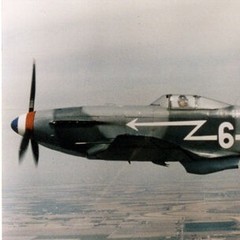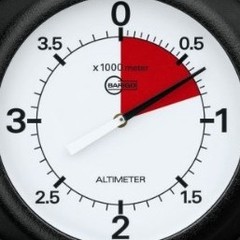-
Posts
17655 -
Joined
-
Last visited
-
Days Won
8
About Yo-Yo
- Birthday August 1
Personal Information
-
Interests
неправильный многогранник
-
Occupation
стажер
Recent Profile Visitors
The recent visitors block is disabled and is not being shown to other users.
-

DCS МИГ-29 ФМ и всё что связано с аэродинамикой 29го
Yo-Yo replied to Leva's topic in DCS: Горячие Скалы 3
Эти усилия оптимизированы под реальный самолет с реальными перегрузками. -
Элементарно. Чем выше температура, тем больше теплоотдача в воздух в радиаторе при прочих равных.
-
Only a paper map. I mean that Duxford airfield is much smoother than a lawn where I measured friction.
-
If we want to find a state for a time moment when the plane stops sinking its CoG, the stroke length DOES NOT MATTER. As I wrote before it's only a matter of momentum. You can expand this process or make it very short - the resulting angular velocity increasing your AoA will be the same. The only difference could be that very long stroke and long time of angular velocity rising allows to react and pull the stick forward. But anyway, the strokes for any certain plane is determined, so we have to deal with real parameters. Regarding the second pint: I thought that you meant only initial moment of wheels acceleration at touchdown where rolling friction is not relevant. But, I have to say, that my experiments with the different types of rolling friction for pneumatic gave exactly the same results for quite uneven grass surface (Duxford airfield is much smoother) and smooth tarmac. The reason is that in steady movement bumps are averaged.
-
By further investigation the recommendation to have 0.3-0.5 m/s sink rate at touchdown are proven. Though it requires a lot of training without RL cues, FM and tires itself are ok. Except low sink rate that must be almost constant at least for several seconds. the speed must not be too high or too low - the higher speed is the more extra lift will be due to increased AoA. My touchdown was at 0.6 m/s and it can be considered as a limit for actual gross weight about 7600 kg to perform a wheeler. P.S. Engines on idle just after touchdown prevent from possible bouncing reducing speed and wing lift due to downwash.
-
1. No, because the force, that balloons the aircraft, is not a strut/tire recoil. As the plane CoG moves vertically with V velocity having mV momentum, its undercarriage have to create impulse equal to this momentum to stop vertical CoG movement DURING the forward stroke. Regardless of sagging, rigidness or softness it will create an impuls of F_average*t, where t is the time of the forward stroke. If there is an arm r between contact point and the CoG, this impuls creates an angular velocity that starts to increase AoA. So, in angular movement the equation will be F_average*t*r = J*w, and substituting the first equation w = m*V_average*r/J, thus the resulting pitch/AoA angualar velocity do not depends on t or the stroke length. Increased AoA creates a lot of extra lift and aircraft balloons. 2. Grass has less friction, if you mean the initial moment of wheel acceleration, that helps to decrease AoA. That's why grass is better for taildraggers. If you do not believe me, imagine a football player perfroming slide tackle on tarmac...
-
-
I am quite surprised as you compare two-wheels landing and this kind of arrested landing. First of all - the last one was performed as a three point landing to establish arrester wire contact. The second fact is, that the arrester creates a tremendous moment that place the aircraft CoG in line with the hook end and arrester wire hardpoints.
-
I think, the problem is not in the system or version. For me the main difficulty to land on two wheels is to maintain stable approach with constant and low sink rate at least at last 30 meters of altitude. P-51 has VSI that is easily visible, Mosquito - mmm... sorry. Any other type of flaring requires from me very precise altitude and sink rate estimation, that is a big challenge in virtual world. I do not use VR, so the task becomes even more difficult.
-
Wheels MOI and inertia effect are taken in account in the model, it's very clear mechanics regarding MOI, inertia, arms, etc. All of them are clearly known. But another clear mechanics says that there are two factors affecting the nose up-pitch moment (three, to be accurate, but the arm from the landing gear to CoG is well known regarding weight-and-balance docs) - WEIGHT and SINK RATE. Modern Mosquito does not land with 9000 kg of gross weight. They are lighter itself (no weapons, ammo, armor, old radio, etc) and they almost never land with full fuel loads. The second factor is sink rate. Real video shows very low sink rate before touchdown not more than 0.3-0.4 m/s. DCS planes can be landed on two wheels keeping in mind all these factors. There is a fourth factor, though, but it is rather human than physical: this small stick movement on touchdown. In RL control inputs based on small accelerations are intuitive and way easier than in simulation, because the control loop acceleration-muscle reaction as a reflex is much faster than visual (position) - muscle reaction. It is a phenomena of a bicycle - riding a virtual bicycle is close to impossible, even if you have years of RL biking practice.
-

need track replay Ground effect - Super carrier
Yo-Yo replied to flybull's topic in DCS: Supercarrier
To find out the origin of the effect try MiG-29. It has pronounced nose-down trim effect close to the ground. Try it on concrete first to get acquainted and then try over a CV. -
To avoid differences between DCS versions (our trunk and release) could you test Channel map and airfields there? My tests were performed using Caucasus and Channel. By the way, compare the Mosquito tail wheel with 10 cm tyre profile and the same rubber strut travel loaded with about 1000 kg and car suspension for 250-500 kg load
-
I have not Normandy map, just Dover and Caucasus and I have some questions to the surface noise we have now. New suspension model is much more accurate and, thus, more sensitive to the stimulus, and watching the tail wheel movement in details I can say that bumps seems to be like cobblestone road.. Dover map shows no significant issues for us. It was a fun testing it hardly :).
-
No, wheels do not cumulate damages.
-
We will check. Our tests show that bumps that are even more than any common sense do not hurt the wheel, probably it's some surfaces issues.











